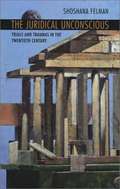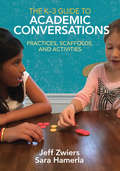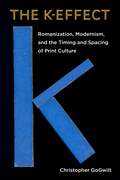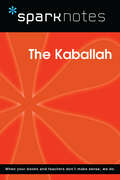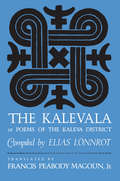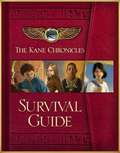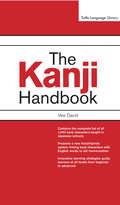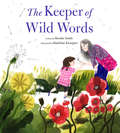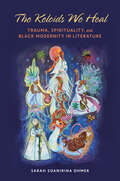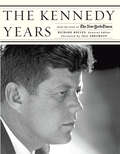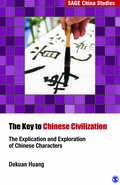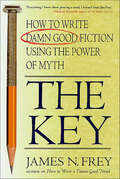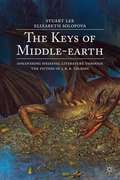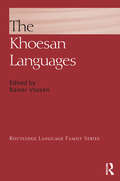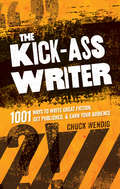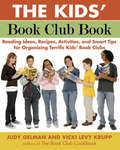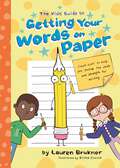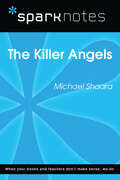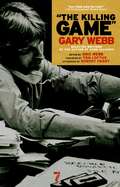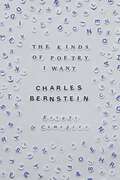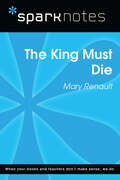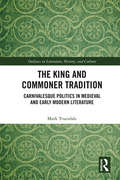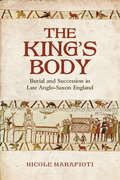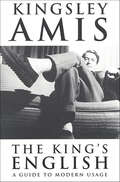- Table View
- List View
The Juridical Unconscious: Trials and Traumas in the Twentieth Century
by Shoshana FelmanDeath, wrote Walter Benjamin, lends storytellers all their authority. How do trials, in turn, borrow their authority from death? This book offers a groundbreaking account of the surprising interaction betweenm trauma and justice.
The K-3 Guide to Academic Conversations: Practices, Scaffolds, and Activities
by Jeff Zwiers Sara R. Hamerla“For thousands of years people have been using the skills we describe in this book to engage in conversations with others. What isn’t as prevalent, however, is instruction--especially in primary grades—in which we engage students in productive conversations about academic ideas. This book fills that very big need.” --Jeff Zwiers & Sara Hamerla Talk about content mastery . . . Primary teachers, you won’t want to miss this: if you’re looking for a single resource to foster purposeful content discussions and high-quality interpersonal engagement, then put Jeff Zwiers and Sara Hamerla’s K-3 Guide to Academic Conversations at the top of your reading list. Whether your students love to talk or not, all must be equipped with key conversation skills such as active listening, taking turns, posing, clarifying, supporting with examples, and arguing ideas. This ready resource comes packed with every imaginable tool you could need to make academic conversations part of your everyday teaching: Sample lesson plans and anchor charts Guidelines for creating effective prompts Applications across content areas, with corresponding assessments Rubrics and protocols for listening to student speech Transcripts of conversations and questions for reflection Companion website with video and downloadable resources Tens of thousands of students in the upper grades have reaped the benefits of academic conversations: high-quality face-to-face interactions, increased motivation, stronger collaborative argumentation skills, and better understanding and retention of content. The K-3 Guide to Academic Conversations is that resource for providing your primary students with the same powerful learning opportunities.
The K-3 Guide to Academic Conversations: Practices, Scaffolds, and Activities
by Jeff Zwiers Sara R. Hamerla“For thousands of years people have been using the skills we describe in this book to engage in conversations with others. What isn’t as prevalent, however, is instruction--especially in primary grades—in which we engage students in productive conversations about academic ideas. This book fills that very big need.” --Jeff Zwiers & Sara Hamerla Talk about content mastery . . . Primary teachers, you won’t want to miss this: if you’re looking for a single resource to foster purposeful content discussions and high-quality interpersonal engagement, then put Jeff Zwiers and Sara Hamerla’s K-3 Guide to Academic Conversations at the top of your reading list. Whether your students love to talk or not, all must be equipped with key conversation skills such as active listening, taking turns, posing, clarifying, supporting with examples, and arguing ideas. This ready resource comes packed with every imaginable tool you could need to make academic conversations part of your everyday teaching: Sample lesson plans and anchor charts Guidelines for creating effective prompts Applications across content areas, with corresponding assessments Rubrics and protocols for listening to student speech Transcripts of conversations and questions for reflection Companion website with video and downloadable resources Tens of thousands of students in the upper grades have reaped the benefits of academic conversations: high-quality face-to-face interactions, increased motivation, stronger collaborative argumentation skills, and better understanding and retention of content. The K-3 Guide to Academic Conversations is that resource for providing your primary students with the same powerful learning opportunities.
The K-Effect: Romanization, Modernism, and the Timing and Spacing of Print Culture
by Christopher GoGwiltThe K-Effect shows how the roman alphabet has functioned as a standardizing global model for modern print culture. Investigating the history and ongoing effects of romanization, Christopher GoGwilt reads modernism in a global and comparative perspective, through the works of Joseph Conrad and others. The book explores the ambiguous effect of romanized transliteration both in the service of colonization and as an instrument of decolonization. This simultaneously standardizing and destabilizing effect is abbreviated in the way the letter K indexes changing hierarchies in the relation between languages and scripts. The book traces this K-effect through the linguistic work of transliteration and its aesthetic organization in transnational modernism.The book examines a variety of different cases of romanization: the historical shift from Arabic script to romanized print form in writing Malay; the politicization of language and script reforms across Russia and Central Europe; the role of Chinese debates about romanization in shaping global transformations in print media; and the place of romanization between ancient Sanskrit models of language and script and contemporary digital forms of coding. Each case study develops an analysis of Conrad’s fiction read in comparison with such other writers as James Joyce, Lu Xun, Franz Kafka, and Pramoedya Ananta Toer. The first sustained cultural study of romanization, The K-Effect proposes an important new way to assess the multi-lingual and multi-script coordinates of modern print culture.
The Kabbalah (SparkNotes Philosophy Guide)
by SparkNotesThe Kabbalah (SparkNotes Philosophy Guide) Making the reading experience fun! SparkNotes Philosophy Guides are one-stop guides to the great works of philosophy–masterpieces that stand at the foundations of Western thought. Inside each Philosophy Guide you&’ll find insightful overviews of great philosophical works of the Western world.
The Kalevala: Or, Poems of the Kaleva District
by Elias LönnrotThe national folk epic of Finland is here presented in an English translation that is both scholarly and eminently readable. To avoid the imprecision and metrical monotony of earlier verse translations, Francis Magoun has used prose, printed line for line as in the original so that repetitions, parallelisms, and variations are readily apparent. The lyrical passages and poetic images, the wry humor, the tall-tale extravagance, and the homely realism of the Kalevala come through with extraordinary effectiveness.
The Kane Chronicles Survival Guide (Kane Chronicles)
by Rick RiordanFans of The Kane Chronicles series will adore this gorgeous primer on the people, places, gods, and creatures found in Rick Riordan's #1 New York Times bestselling series. Boasting lenticulars, an easy-to-assemble trading card pyramid, and full-color diagrams and maps, this deluxe, lavishly illustrated guide teaches readers how to compile secret messages, read hieroglyphics, and recite ancient magic spells. Featuring enough information and extras to satisfy avid followers and budding Egyptologists alike, this guide will cast a spell on readers of all ages.
The Kanji Handbook
by Vee DavidThe Kanji Handbook is a revolutionary new learning technique for students of the Japanese language. This innovative book presents the concept and application of "KanjiHybrids", a teaching tool created by the author to help non-Japanese speakers learn Kanji. Simply put, Vee David has linked the 1,945 most commonly used Kanji characters with English words to form one integral unit, a "Kanji Hybrid". Using mnemonics as a learning tool, the author has replaced the first letter of an English word with the Kanji for that word in an effort to help students memorize difficult Kanji characters.Employing learning strategies that will aid students from beginning to advanced levels, The Kanji Handbook is an exciting new entry into the difficult world of Japanese language learning.
The Keeper of Wild Words: (nature For Kids, Exploring Nature With Children)
by Brooke SmithA touching tale of a grandmother and her granddaughter exploring and cherishing the natural world.Words, the woods, and the world illuminate this quest to save the most important pieces of our language—by saving the very things they stand for.When Mimi finds out her favorite words—simple words, like apricot, blackberry, buttercup—are disappearing from the English language, she elects her granddaughter Brook as their Keeper. And did you know? The only way to save words is to know them.• With its focus on the power of language and social change, The Keeper of Wild Words is ideal for educators and librarians as well as young readers.• For any child who longs to get outside and learn more about nature and the environment• A loving portrait of the special relationship that grandparents have with their grandchildrenFor children who love such books as Outside Your Window: A First Book of Nature, And Then It's Spring, and Finding Wild.Brooke Smith is a poet and children's book author. She lives in Bend, Oregon, at the end of a long cinder lane. Brooke writes daily from her studio, looking at the meadow and many of the wild words she cherishes.Madeline Kloepper is a Canadian artist with a Bachelor of Fine Arts and Major in Illustration from Emily Carr University of Art and Design. Her work is influenced by childhood, nostalgia, and the relationships we forge with nature. She lives in Prince George, British Columbia.
The Keloids We Heal: Trauma, Spirituality, and Black Modernity in Literature (Transformations: Womanist studies)
by Sarah Soanirina OhmerWomen of colors and a literature written in corporeal and spiritual scars The corporeal and spiritual healing in literature by women of colors can be seen to redefine modern thought and printed text. Sarah Soanirina Ohmer traces the impact of colonization and enslavement on Black women and Black women’s contributions to colonial, nineteenth, and twentieth century literature in the US, Brazil, and the Caribbean. Drawing on intersectional analysis, Ohmer focuses on portrayals of trauma and spirituality in works by Toni Morrison, Conceição Evaristo, Maryse Condé, Gloria Anzaldúa, the Quilombhoje poets, and María de los Reyes Castillo. Ohmer compares literature from different countries along four thematic pathways: ghosts, mirrors, naming, and motherhood. Her analysis unlocks the literature’s power to heal through gut-wrenching descriptions of wounds and thrilling passages of hope and liberation. Throughout, Ohmer weaves in her life story as a Black woman as she reflects on how colonialism, racism, sexism, and capitalism have impacted her work, traumas, and faith journey.
The Kennedy Years: From the Pages of The New York Times
by Jill Abramson“A deeply illuminating, journalistic romp through Camelot from the eyes and minds of the great New York Times reporters of that era and beyond.” —Douglas Brinkley, #1 New York Times–bestselling authorDecades after the assassination of John F. Kennedy, he still ranks as one of the top five presidents in every major annual survey. To commemorate the man and his time in office, the New York Times has authorized a book, edited by Richard Reeves, based on its unsurpassed coverage of the tumultuous Kennedy era. The Civil Rights Movement, the Bay of Pigs, the Cuban Missile Crisis, Vietnam, the space program, the Berlin Wall—all are covered in articles by the era’s top reporters, among them David Halberstam, Russell Baker, and James Reston. Also included are new essays by leading historians such as Robert Dallek and Terry Golway, and by Times journalists, including Sam Tanenhaus, Scott Shane, Alessandra Stanley, and Roger Cohen. With more than 125 color and black-and-white photos, this is the ultimate volume on one of history’s most fascinating figures.“This book is both fascinating and poignant. It brings us back into the Kennedy years while also allowing us to reflect on what made them so emotional. I found myself totally immersed.” —Walter Isaacson, #1 New York Times–bestselling author“Provides much more than a riveting first draft of history. Here we also witness the birth of modern America.” —Cokie Roberts, former political commentator and #1 New York Times–bestselling author “A terrific introduction to the Kennedy presidency for those who did not live through it, and a startling reminder for those who did of how much happened in those 1,000 days.” —David Nasaw, New York Times–bestselling author
The Key to Chinese Civilization: The Explication and Exploration of Chinese Characters (SAGE China Studies)
by Dekuan HuangThe Key to Chinese Civilization: The Explication and Exploration of Chinese Characters is a fascinating guide to the history of the Chinese civilization, which has been recorded not just by means of the Chinese characters but also in the characters themselves. It studies the long history of Chinese characters, the laws of their construction and development, and what their correct interpretation can mean for contemporary communication. The Chinese writing system, vastly different from phonetic alphabet systems and the oldest continuously used system of writing in the world, is dynamic and its evolution reveals much about the historical and sociocultural development of China. The book shows how the interpretation of the cultural connotation of Chinese characters is necessary, even crucial, though it is a daunting task. It proposes a scientific method for this kind of interpretation and gives elaborate examples. Authored by an expert in philology and palaeography, the book is written in simple language and will be of great help to Chinese language enthusiasts.
The Key: How to Write Damn Good Fiction Using the Power of Myth
by James N. FreyIn his widely read guides How to Write a Damn Good Novel and How to Write a Damn Good Novel II: Advanced Techniques, popular novelist and fiction-writing coach James N. Frey showed tens of thousands of writers how--starting with rounded, living, breathing, dynamic characters--to structure a novel that sustains its tension and development and ends in a satisfying, dramatic climax.Now, in The Key, Frey takes his no-nonsense, "Damn Good" approach and applies it to Joseph Campbell's insights into the universal structure of myths. Myths, says Frey, are the basis of all storytelling, and their structures and motifs are just as powerful for contemporary writers as they were for Homer. Frey begins with the qualities found in mythic heros--ancient and modern--such as the hero's special talent, his or her wound, status as an "outlaw," and so on. He then demonstrates how the hero is initiated--sent on a mission, forced to learn the new rules, tested, and suffers a symbolic death and rebirth--before he or she can return home. Using dozens of classical and contemporary novels and films as models, Frey shows how these motifs and forms work their powerful magic on the reader's imagination.The Key is designed as a practical step-by-step guide for fiction writers and screen writers who want to shape their own ideas into a mythic story.
The Keys of Middle-earth: Discovering Medieval Literature Through The Fiction Of J. R. R. Tolkien
by Stuart Lee Elizabeth SolopovaThe Keys of Middle-Earth uniquely introduces the reader to the world of Medieval Literature through the fiction of J.R.R. Tolkien. Using key episodes in The Hobbit and The Lord of the Rings, readers are taken back to the works of Old, Middle English and Old Norse literature that so influenced Tolkien. The original texts are presented with helpful new translations to help the reader approach the medieval poems and tales, and introductory essays draw on recent scholarship and Tolkien's own unpublished notes. Presenting a new era of Tolkien studies, this book will be of use to students (and teachers) of Medieval/Old English literature and general readers interested in the origins of Tolkien's most widely-known works.
The Khoesan Languages (Routledge Language Family Series)
by Rainer VossenThe Routledge Language Family series is aimed at undergraduates and postgraduates of linguistics and language, and those with an interest in historical linguistics, linguistic anthropology and language development. According to a widely accepted hypothesis, the Khoesan languages represent the smallest of the four language phyla in Africa, geographically distributed mainly in Botswana and Namibia. Today, only 30 or so Khoesan languages may still exist, with about 300,000 native speakers. In other words, most Khoesan languages were already extinct before a sound scholarly interest in them could begin to develop. Drawing together a distinguished group of international experts, with much of the material taken from data collected by the authors’ own field work, this volume presents descriptive, typological, historical-comparative and sociolinguistic material on Khoesan. The Khoesan Languages contains eight sections: an introduction, an overview of genetic relationships, a typological survey and profile of Khoesan, four chapters covering core linguistic areas of Khoesan phonetics and phonology, tonology, morphology and syntax, and a final chapter tackling major issues in Khoesan sociolinguistics, as well as discussions of language contact. Comprehensive and scholarly, yet also lucid in its coverage of a broad range of languages, dialects and sub-groups, this unprecedented and original work represents the current state of Khoesan linguistics.
The Kick-Ass Writer: 1001 Ways to Write Great Fiction, Get Published, and Earn Your Audience
by Chuck WendigThe journey to become a successful writer is long, fraught with peril, and filled with difficult questions: How do i write dialogue? How do I build suspense? What should I know about query letters? Where do I start? The best way to answer these questions is to ditch your uncertainty and transform yourself into a KICK-ASS writer. Chuck Wendig will show you how with an explosive broadside of gritty advice that will destroy your fears, clear the path, and help you find your voice, your story, and your audience. You'll explore the fundamentals of writing, learn how to obtain publication, and master the skills you need to build an army of dedicated fans. No task is too large or small for the kick-ass writer. With his trademark acerbic wit and gut-punch humor, Wendig will explain: How to build suspense, craft characters, and defeat writer's block. How to write a scene, an ending--even a sentence. Blogging techniques, social media skills, and crowdfunding. How to write a query letter, talk to agents, and deal with failure--and success! Whether you're just starting out or you need one more push to get you over the top, two things are certain--a kick-ass writer never quits, and Chuck Wendig won't let you down in this high-octane guide to becoming the writer you were born to be!
The Kids' Book Club Book
by Judy Gelman Vicki Levy KruppThe first complete guide-for use by adults and children-to creating fun and educational book clubs for kids. As authors of The Book Club Cookbook, the classic guide to integrating great food and food-related discussion into book club gatherings, Judy Gelman and Vicki Levy Krupp hear a common refrain from parents, librarians, teachers, community leaders and kids themselves: "How about writing a book for kids' book clubs?" Indeed, in recent years youth organizations, parents, libraries, schools, and our local, state, and federal governments have launched thousands of book clubs for children as a way to counter falling literacy rates and foster a love of reading. Based on surveys representing five hundred youth book clubs across the country and interviews with parents, kids, educators, and librarians, The Kids' Book Club Bookfeatures: _- the top fifty favorite book club reads for children ages eight to eighteen; _- ideas and advice on forming great kids' book clubs-and tips for kids who want to start their own book clubs; _- recipes, activities, and insights from such bestselling children's book authors as Christopher Paolini, Lois Lowry, Jerry Spinelli, Nancy Farmer, Christopher Paul Curtis, Andrew Clements, Laurie Halse Anderson, Norton Juster, and many others. From recipes for the Dump Punch and egg salad sandwiches included in Kate DiCamillo's Because of Winn-Dixie to instructionson how to make soap carvings like the ones left in the knot-hole of a tree in Harper Lee's To Kill a Mockingbird, this book provides a bounty of ideas for making every kids' book club a success.
The Kids’ Guide to Getting Your Words on Paper: Simple Stuff to Build the Motor Skills and Strength for Handwriting
by Lauren BruknerDoes your hand ache when you write? Packed with fun and simple ideas to help kids feel good about writing, this handwriting book with a difference helps children embed the strength and skills they need to get the most out of their written work, at home and school!From different kinds of cushions, hand warm-ups, and cool eye scan exercises, and pencil grips to yoga balls in cardboard boxes, personalized activity binders, playdough, lego, and Velcro on pencils, this book is filled with fun stuff to help kids focus, get stronger, and be in control of their writing. The strategies in the book are accompanied by cartoon-style illustrations, and the author includes useful tips for parents and teachers as well as handy visual charts, a quiz to identify areas of most difficulty, and checklists for children to track their own progress.Armed with the strategies and exercises in this book, kids will be well on their way to writing with greater ease, and the positive self-esteem that goes along with that. Suitable for children with writing difficulties aged approximately 7 to 12.
The Killer Angels (SparkNotes Literature Guide Series)
by SparkNotesThe Killer Angels (SparkNotes Literature Guide) by Michael Shaara Making the reading experience fun! Created by Harvard students for students everywhere, SparkNotes is a new breed of study guide: smarter, better, faster. Geared to what today's students need to know, SparkNotes provides: *Chapter-by-chapter analysis *Explanations of key themes, motifs, and symbols *A review quiz and essay topicsLively and accessible, these guides are perfect for late-night studying and writing papers
The Killing Game
by Gary WebbGary Webb had an inborn journalistic tendency to track down corruption and expose it. For over thirty-four years, he wrote stories about corruption from county, state, and federal levels. He had an almost magnetic effect to these kinds of stories, and it was almost as if the stories found him. It was his gift, and, ultimately, it was his downfall.He was best known for his story Dark Alliance, written for the San Jose Mercury News in 1996. In it Webb linked the CIA to the crack-cocaine epidemic in Los Angeles during the Iran Contra scandal. His only published book, Dark Alliance is still a classic of contemporary journalism. But his life consisted of much more than this one story, and The Killing Game is a collection of his best investigative stories from his beginning at the Kentucky Post to his end at the Sacramento News & Review. It includes Webb's series at the Kentucky Post on organized crime in the coal industry, at the Cleveland Plain Dealer on Ohio State's negligent medical board, and on the US military's funding of first-person shooter video games. The Killing Game is a dedication to his life's work outside of Dark Alliance, and it's an exhibition of investigative journalism in its truest form.
The Kinds of Poetry I Want: Essays & Comedies
by Charles BernsteinA celebration of the radical poetics of invention from Charles Bernstein. For more than four decades, Charles Bernstein has been at the forefront of experimental poetry, ever reaching for a radical poetics that defies schools, periods, and cultural institutions. The Kinds of Poetry I Want is a celebration of invention and includes not only poetry but also essays on aesthetics and literary studies, interviews with other poets, autobiographical sketches, and more. At once a dialogic novel, long poem, and grand opera, The Kinds of Poetry I Want arrives amid renewed attacks on humanistic expression. In his polemical, humorous style, Bernstein faces these challenges head-on and affirms the enduring vitality and attraction of poetry, poetics, and literary criticism.
The King Must Die (SparkNotes Literature Guide Series)
by SparkNotesThe King Must Die (SparkNotes Literature Guide) by Mary Renault Making the reading experience fun! Created by Harvard students for students everywhere, SparkNotes is a new breed of study guide: smarter, better, faster.Geared to what today's students need to know, SparkNotes provides:*Chapter-by-chapter analysis *Explanations of key themes, motifs, and symbols *A review quiz and essay topicsLively and accessible, these guides are perfect for late-night studying and writing papers
The King and Commoner Tradition: Carnivalesque Politics in Medieval and Early Modern Literature (Outlaws in Literature, History, and Culture #4)
by Mark TruesdaleKing and Commoner tales were hugely popular across the late medieval and early modern periods, their cultural influence extending from Robin Hood ballads to Shakespearean national histories. This study represents the first detailed exploration of this rich and fascinating literary tradition, tracing its development across deeply politicized fifteenth-century comic tales and early modern ballads. The medieval King and Commoner tales depict an incognito king becoming lost in the forest and encountering a disgruntled commoner who complains of class oppression and poaches the king’s deer. This is an upside-down world of tricksters, violence, and politicized feasting that critiques and deconstructs medieval hierarchy. The commoners of these tales utilize the inversion of the medieval carnival, crowning themselves as liminal mock kings in the forest while threatening to rend and devour a body politic that would oppress them. These tales are complex and ambiguous, reimagining the socio-political upheaval of the late medieval period in sophisticated ruminations on class relations. By contrast, the early modern ballads and chapbooks see the tradition undergo a conservative metamorphosis. Suppressing its more radical elements amid a celebration of proto-panoptical kings, the tradition remerges as royalist propaganda in which the king watches his thankful subjects through the keyhole.
The King's Body: Burial and Succession in Late Anglo-Saxon England (Toronto Anglo-saxon Ser.)
by Nicole MarafiotiThe King's Body investigates the role of royal bodies, funerals, and graves in English succession debates from the death of Alfred the Great in 899 through the Norman Conquest in 1066. Using contemporary texts and archaeological evidence, Nicole Marafioti reconstructs the political activity that accompanied kings' burials, to demonstrate that royal bodies were potent political objects which could be used to provide legitimacy to the next generation.In most cases, new rulers celebrated their predecessor's memory and honored his corpse to emphasize continuity and strengthen their claims to the throne. Those who rose by conquest or regicide, in contrast, often desecrated the bodies of deposed royalty or relegated them to anonymous graves in attempts to brand their predecessors as tyrants unworthy of ruling a Christian nation. By delegitimizing the previous ruler, they justified their own accession. At a time when hereditary succession was not guaranteed and few accessions went unchallenged, the king's body was a commodity that royal candidates fought to control.
The King's English: A Guide to Modern Usage
by Kingsley AmisA Parthian shot from one of the most important figures in post-war British fiction, The King's English is the late Kingsley Amis's last word on the state of the language. More frolicsome than Fowler's Modern Usage, lighter than the Oxford English Dictionary, and brimming with the strong opinions and razor-sharp wit that made Amis so popular--and so controversial--The King's English is a must for fans and language purists.
